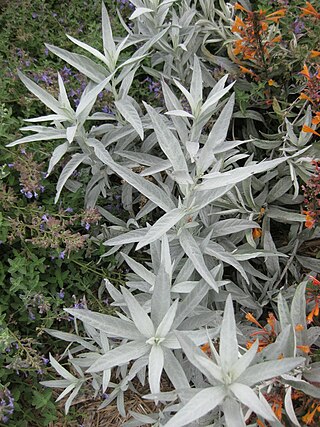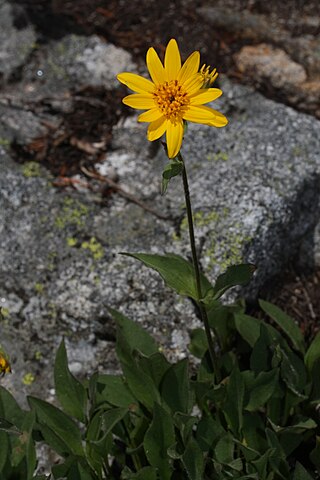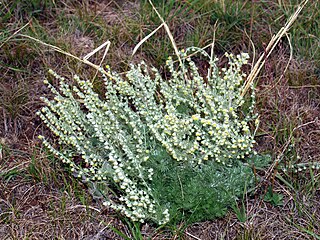
Artemisia is a large, diverse genus of plants belonging to the daisy family Asteraceae, with between 200 and 400 species. Common names for various species in the genus include mugwort, wormwood, and sagebrush.

Artemisia vulgaris, the common mugwort, is a species of flowering plant in the daisy family Asteraceae. It is one of several species in the genus Artemisia commonly known as mugwort, although Artemisia vulgaris is the species most often called mugwort. It is also occasionally known as riverside wormwood, felon herb, chrysanthemum weed, wild wormwood, old Uncle Henry, sailor's tobacco, naughty man, old man, or St. John's plant. Mugworts have been used medicinally and as culinary herbs.

Artemisia absinthium, otherwise known as common wormwood, is a species of Artemisia native to North Africa and temperate regions of Eurasia, and widely naturalized in Canada and the northern United States. It is grown as an ornamental plant and is used as an ingredient in the spirit absinthe and some other alcoholic beverages.
Artemisia alaskana, the Alaskan sagebrush or Alaskan wormwood or Siberian wormwood, is a North American species of plants in the sunflower family. It is found in British Columbia, the Yukon, the Northwest Territories, and Alaska. Some authors have considered it as a subspecies as the Russian species A. kruhsiana.

Artemisia ludoviciana is a North American species of flowering plant in the daisy family Asteraceae, known by several common names, including silver wormwood, western mugwort, Louisiana wormwood, white sagebrush, lobed cud-weed, prairie sage, and gray sagewort.

Chaenactis artemisiifolia, with the common name white pincushion, is a species of flowering plant in the daisy family. It is native to the coastal Peninsular Ranges of Southern California and Baja California, in the chaparral and woodlands.

Arnica mollis is a North American species of arnica in the sunflower family, known by the common name soft arnica, or hairy arnica. It is native to Canada and the United States (Alaska and the western mountains as far south as San Bernardino County, California and Rio Arriba County, New Mexico. There are also isolated populations in the White Mountains of Coos County, New Hampshire. The species grows in subalpine mountain habitat such as meadows and streambanks.

Artemisia biennis is a species of sagebrush known by the common name biennial wormwood. It is a common and widely distributed weed, so well established in many places that its region of origin is difficult to ascertain. This species is most likely native to northwestern North America and naturalized in Western Europe, and eastern and southern North America.

Artemisia michauxiana is a North American species of wormwood in the sunflower family. It is known by the common names Michaux's wormwood and lemon sagewort. It is native to the western United States and Canada. It grows in mountain talus habitats in subalpine to alpine climates.

Artemisia nova is a North American species of sagebrush, known by the common name black sagebrush. It is "one of the most common shrubs in the western United States".

Artemisia suksdorfii is a North American species of sagebrush in the sunflower family. It is known by the common names coastal mugwort, coastal wormwood, and Suksdorf sagewort. It is native to coastal regions from British Columbia, Washington, Oregon, and northern California as far south as Sonoma County, with isolated populations on Santa Catalina Island in Los Angeles County.

Veronica wormskjoldii is a species of flowering plant in the plantain family known by the common name American alpine speedwell. It is native to much of northern and western North America, including the western United States and northern Canada, from where it grows in moist alpine habitat, such as mountain forest understory. It has a wide subarctic distribution from Alaska to Greenland.

Sagina maxima is a species of flowering plant in the family Caryophyllaceae known by the common names stickystem pearlwort and thick-stemmed pearlwort. It is native to the west coast of North America from Alaska to California, where it can be found in many types of sandy and rocky coastal habitat. It is a small, fleshy perennial herb growing in a clump of linear leaves and thick stems. The fleshy, pointed leaves are 1 or 2 centimeters long. The inflorescence is a solitary flower with five sepals and five small white petals. There are two subspecies which differ mainly in the arrangement of hairs on the stem.

Solidago multiradiata is a species of goldenrod known by the common names Rocky Mountain goldenrod, northern goldenrod, and alpine goldenrod. It is native to North America, where it can be found throughout the northern regions, including Alaska and most of Canada (all 3 territories plus all provinces except Prince Edward Island, including territory north of the Arctic Circle. Its distribution extends through the western United States as far south as Arizona, New Mexico, and California. It is known mostly from the subalpine and alpine climates of high mountain ranges. Its habitat includes tundra and mountain meadows.

Artemisia norvegica is a species of flowering plant in the aster family known by the common names alpine sagewort, boreal sagewort, mountain sagewort, Norwegian mugwort, arctic wormwood, and spruce wormwood. It is found in cold locations in Eurasia and high altitudes and high latitudes in North America.
Elymus macrourus is a species of grass known by the common names tufted wheatgrass and thickspike wildrye. It is native to northwestern North America in Alaska, Yukon, and the Northwest Territories. It is also present in eastern Siberia.

Artemisia frigida is a widespread species of flowering plant in the aster family, which is known as the sunflower family. It is native to Europe, Asia, and much of North America. In parts of the north-central and northeastern United States it is an introduced species.

Artemisia pedatifida is a species of flowering plant in the aster family known by the common names birdfoot sagebrush and matted sagewort. It is native to a section of the west-central United States encompassing parts of Idaho, Montana, Wyoming and Colorado, where it occurs on the high plains.
Artemisia porteri is a species of flowering plant in the aster family known by the common names Porter's sagebrush, Porter's wormwood, and Porter mugwort. It is endemic to Wyoming in the United States, where it is known from Fremont, Johnson and Natrona Counties.
Eriogonum visheri is a species of wild buckwheat known by the common names Dakota wild buckwheat and Visher's buckwheat. It is native to the Great Plains in the United States, where it is known from North Dakota, South Dakota, and Montana.

















